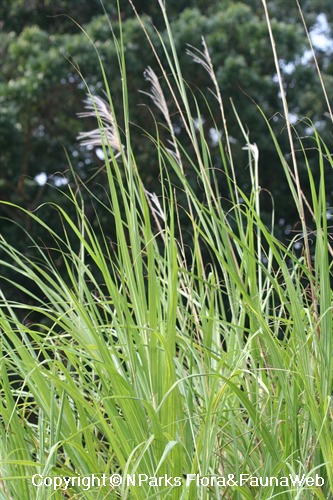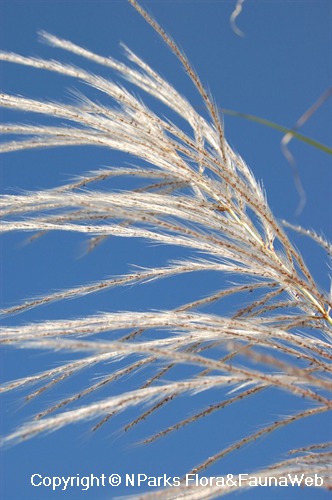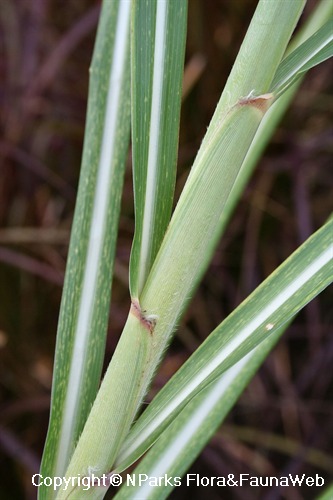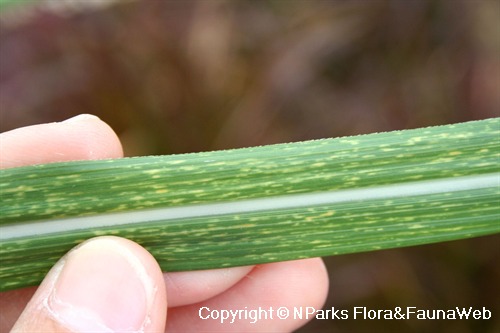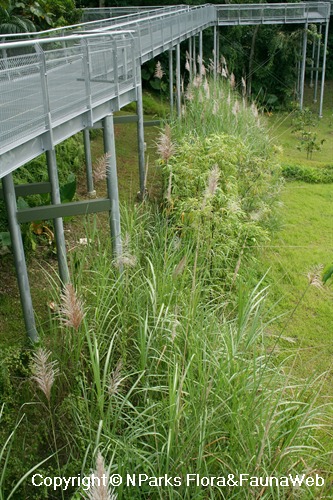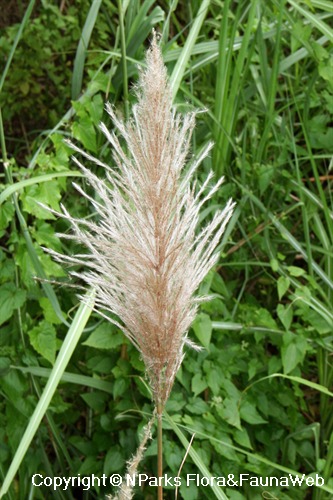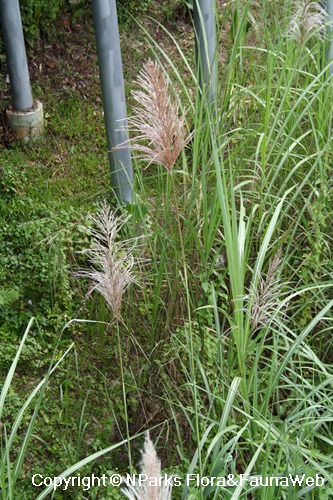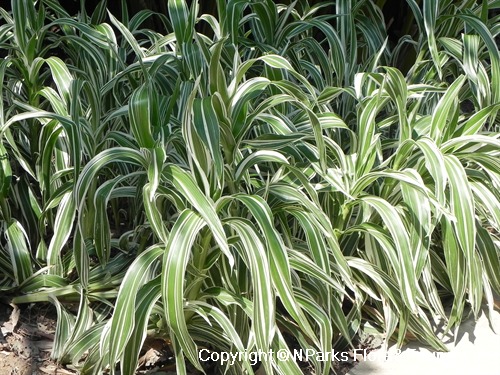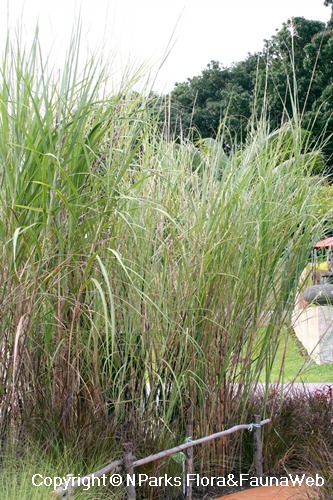
Back
Saccharum spontaneum L.
| Family Name: | Poaceae (Gramineae) |
| Synonyms: | Saccharum canaliculatum Roxb., Saccharum semidecumbens (Roxb.) Schult., Saccharum propinquum Steud., Imperata spontanea (L.) P.Beauv. |
| Common Name: | Wild Sugarcane, Kans Grass, Fodder Cane, African Fodder Cane, Asian Fodder Cane, 甜根子草 |
Name
Classifications and Characteristics
| Plant Division | Angiosperms (Flowering Seed Plants) (Monocotyledon) |
|---|---|
| Plant Growth Form | Grass or Grass-like Plant |
| Lifespan (in Singapore) | Perennial |
| Mode of Nutrition | Autotrophic |
| Plant Shape | Irregular |
| Maximum Height | 2 m to 4 m |
Biogeography
| Native Distribution | Eastern and northern Africa, India (including Assam), Bangladesh, Central Asia, China, Taiwan, Japan, Myanmar, Laos, Vietnam, Cambodia, Thailand, Peninsular Malaysia, Philippines, Sumatra, Java, New Guinea, Australia (Northern Territory) & the Solomon Islands. |
|---|---|
| Native Habitat | Terrestrial (Coastal Forest, Riverine, Grassland / Savannah/ Scrubland, Disturbed Area / Open Ground, Secondary Rainforest) |
| Preferred Climate Zone | Tropical, Sub-Tropical / Monsoonal, Temperate |
| Local Conservation Status | Non-native |
Description and Ethnobotany
| Growth Form | It is a tall, fast-growing, perennial clumping grass, up to 4m tall, with an erect habit, deep roots, and long spreading rhizomes. |
|---|---|
| Foliage | The leaf blades are linear, green with a white midrib, measuring 0.4–2 m long × 2–30 mm wide, and finely serrated, prickly margins. |
| Stems | The culms (aboveground stems of grasses and grass-like monocots) are slender, erect, measuring 1–6 m tall × 0.3–1.5 cm in diameter. They are fibrous with little juice, and turn brown or black when mature. The nodes (stem joints) are bearded. |
| Flowers | The inflorescence is a panicle of racemes with spikelets and silky white or purple hairs. Each spikelet comprises 2 florets, each consisting of heavily reduced petals and sepals, anthers, stigmas, and white hairs (2–4 times as long as each spikelet). The inflorescence is borne at the terminal end of the culm. The species blooms towards the end of the rainy season in its native range, but is rather free-flowering in Singapore.. |
| Fruit | The fruit is a caryopsis (a type of dry, indehiscent fruit, commonly known as a grain). The fruits are tufted and dispersed by the wind. |
| Habitat | It can be found typically along river banks, lake sides, freshwater and saline marshes, sandy beaches, dunes, silt plains and grasslands. |
| Taxonomy | This species is a secondary genetic relative of Saccharum officinarum or Sugarcane. |
| Cultivation | This species grows in full sun to slightly shaded conditions and withstands a wide range of soil types, including alluvial, infertile, sandy and saline soils. It prefers lots of moisture, but is tolerant of drought. Prune regularly and use gloves to prevent cuts by sharp leaf edges. It is propagated by seeds and rhizome division. |
| Etymology | The genus Saccharum' is derived from Greek sakcharon'bamboo sugar' but later meaning 'sugarcanes'. The specific epithet spontaneum means 'spontaneous', referring to wild growing species i.e. not cultivated. |
| Ethnobotanical Uses | Food (Herb or Spice) Medicinal: Roots regarded in Ayurvedic medicine as sweet, astringent and diuretic -- used to treat respiratory problems, constipation and piles. Others: This species is crossed with the economically important relative Saccharum officinarum (Sugarcane) to produce disease-resistant sugarcane varieties. Tender young leaves are used as fodder for buffaloes and cattle in India, and to feed elephants in other areas. Young leaves are also used to make hay for dry-season feed. |
Landscaping Features
| Landscape Uses | General, Coastal, Riverine, Beachfront / Shoreline |
|---|---|
| Thematic Landscaping | Naturalistic Garden, Wildflower Garden |
| Usage Hazard - Cons | Spines/Thorns - Leaf |
| Usage Hazard - Cons Remarks | Spines/Thorns - Leaf: The sharp leaf margins are lined with fine hairs. Use gloves to prevent cuts when handling the culms. |
| Plant & Rootzone Preference or Tolerance Remarks | Tolerates wide range of soils, including infertile shifting sand dunes. |
Fauna, Pollination and Dispersal
| Fauna Pollination Dispersal Associated Fauna | Bird-Attracting |
|---|---|
| Pollination Method(s) | Abiotic (Wind) |
| Seed or Spore Dispersal | Abiotic |
Plant Care and Propagation
| Light Preference | Full Sun, Semi-Shade |
|---|---|
| Water Preference | Moderate Water, Little Water |
| Plant Growth Rate | Fast |
| Rootzone Tolerance | Drought Tolerant, Well-Drained Soils, Poor Infertile Soils, Waterlogged Soils (Drains Site), Saline Soils / Salt Spray |
| Maintenance Requirements | Moderate |
| Pest(s) | Chewing Insects |
| Propagation Method | Seed, Division |
Foliar
| Foliage Retention | Evergreen |
|---|---|
| Mature Foliage Colour(s) | Green, White |
| Mature Foliage Texture(s) | Spiny / Bristly / Stinging |
| Foliar Type | Simple / Unifoliate |
| Foliar Arrangement Along Stem | Alternate |
| Foliar Attachment to Stem | Sessile |
| Foliar Shape(s) | Non-Palm Foliage (Linear) |
| Foliar Venation | Parallel |
| Foliar Margin | Serrate / Toothed |
| Foliar Apex - Tip | Acuminate |
| Foliar Base | Cuneate |
| Typical Foliar Area | Notophyll ( 20.25cm2 - 45 cm2 ) |
| Leaf Area Index (LAI) for Green Plot Ratio | 3.5 (Shrub & Groundcover - Monocot) |
Non - Foliar and Storage
| Stem Type & Modification | Herbaceous |
|---|---|
| Root Type | Underground (Fibrous Root) |
| Specialised Storage Organ(s) | Underground (Rhizome) |
Floral (Angiosperm)
| Flower & Plant Sexuality | Bisexual Flowers |
| Flower Colour(s) | Cream / Off-White, White, Purple |
|---|---|
| Flower Texture(s) | Hairy / Hirsute |
| Flower Grouping | Cluster / Inflorescence |
| Flower Location | Terminal |
| Inflorescence Type | Panicle, Spikelet / Pseudospikelet / Compound Spike |
| Flowering Period | Free-Flowering |
| Flowering Opening Time | Time-Independent |
| Flower Lifespan on Plant | Several Days |
| Flowering Habit | Polycarpic |
Fruit, Seed and Spore
| Mature Fruit Colour(s) | Brown |
|---|---|
| Fruit Classification | Simple Fruit |
| Fruit Type | Indehiscent Dry Fruit , Caryopsis / Grain |
References
| References | Veldkamp, J.F., Duistermaat, H., Wong, K.M., & Middleton, D.J. (2019). Poaceae (Gramineae). Flora of Singapore, Volume 7. Singapore: National Parks Board. pp 219 - 501. |
|---|
Image Repository
Others
| Master ID | 17192 |
|---|---|
| Species ID | 3340 |
| Flora Disclaimer | The information in this website has been compiled from reliable sources, such as reference works on medicinal plants. It is not a substitute for medical advice or treatment and NParks does not purport to provide any medical advice. Readers should always consult his/her physician before using or consuming a plant for medicinal purposes. |

